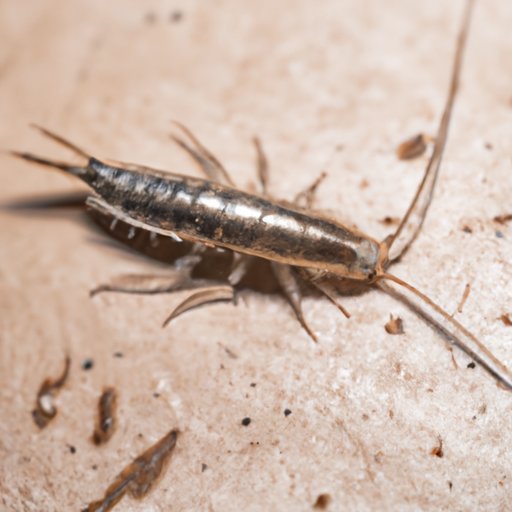
Introduction
Silverfish, scientifically known as Lepisma saccharina, are small, wingless insects that have been in existence for millions of years. They are known for their unique body shape, which is elongated and tapers to a point at the end. These insects are mainly nocturnal and thrive in moist and humid environments. Silverfish are often considered pests in homes as they can cause significant damage to personal belongings such as books, paper, and clothing. In this article, we explore natural remedies, preventative measures, and commercial products that can be used to control and eliminate silverfish infestations.
Natural Remedies for Getting Rid of Silverfish
Natural remedies offer an effective and eco-friendly alternative to the traditional commercial products used to combat silverfish infestations. Essential oils, such as lavender oil, peppermint oil, and cedarwood oil, work by repelling the insects through their strong scent. Boric acid, a white, odorless powder, kills silverfish by damaging their exoskeleton, leading to dehydration, and eventually death. While diatomaceous earth works by dehydrating the insects’ bodies, causing them to die within a few days. These natural remedies are safe for use around pets and children and can be applied using cotton balls or a spray bottle.
It’s important to note that natural remedies may require several applications before showing results. They also tend to be less effective against severe infestations, especially when compared to commercial products.
Preventative Measures to Avoid a Silverfish Infestation
Preventative measures can help reduce the likelihood of a silverfish infestation. Controlling the humidity levels in the house, particularly in basements and crawl spaces, can help prevent a silverfish infestation from taking hold. Fixing any leaks or water damage, removing standing water, and ensuring proper ventilation can help control the moisture levels in these environments. Sealing up cracks, crevices, and holes in walls, baseboards, and other areas can help prevent silverfish from entering the home. Reducing the availability of food sources for silverfish, such as cereals, pasta, and pet food, can also help avoid a silverfish infestation.
Commercial Products for Eliminating Silverfish
Commercial products offer a quick and effective solution to controlling silverfish infestations. Insecticides, typically sold as sprays or dust, work by killing silverfish on contact or through their ingestion of the chemical. Traps, on the other hand, attract silverfish, making them stick to an adhesive surface, where they eventually perish. These products can be found at most hardware stores or can be purchased online, and they come in a range of strengths and formulations. Before applying these products, it’s essential to read and follow all the instructions carefully. It’s also recommended to avoid using insecticides near food-preparation areas and to keep pets and children away from treated areas.
Getting Rid of Silverfish in Specific Areas of the Home
Silverfish tend to prefer warm and humid areas such as bathrooms, kitchens, and basements. To eliminate silverfish in these areas, it’s important to maintain proper hygiene and cleanliness. Cleaning up any spills immediately, vacuuming regularly, and wiping down surfaces can help reduce the food sources for these insects. Using containers with tight lids can help keep food items, particularly those commonly targeted by silverfish, such as flour and sugar, from becoming infested. Sealing any cracks along the walls, baseboards, and windows can also help prevent silverfish from entering the home. Additionally, placing traps or applying non-toxic repellents, such as essential oils, in these specific areas can help repel and eliminate silverfish.
Step-by-Step Guide for Identifying and Eliminating a Silverfish Infestation
Identifying a silverfish infestation involves looking for signs such as yellow stains, scales, and feces left behind by the insects. Once a silverfish infestation is confirmed, eliminating it involves taking a multi-step approach that includes the use of natural remedies, commercial products, and preventative measures. Firstly, it’s important to clean and declutter the affected areas and dispose of any infested materials safely. Once this is done, natural remedies such as essential oils, boric acid, or diatomaceous earth can be applied to repel and reduce the infestation. Traps and insecticides can also be used to eliminate the silverfish more effectively. Finally, sealing up any entry points and reducing moisture levels in the home can help prevent future infestations.
The Importance of Hiring a Pest Control Professional
In severe infestations, or if natural remedies and commercial products have been ineffective, it’s essential to contact a pest control professional to assist in eliminating the silverfish infestation. Pest control professionals have the knowledge, experience, and tools required to tackle severe infestations effectively. These professionals offer a range of treatments, such as fumigation or chemical application, depending on the level of infestation and how widespread it is. They can also offer guidance on preventative measures that can help avoid future infestations.
Conclusion
Getting rid of silverfish infestations requires a multi-faceted approach that includes natural remedies, preventative measures, commercial products, and in some cases, consulting a pest control professional. While natural remedies offer an eco-friendly solution, they may take longer to be effective. Commercial products offer a quick and effective solution but should be used carefully. Preventative measures can help avoid future infestations, and a professional pest control service can assist in tackling severe infestations effectively. By following these steps, homeowners can ensure a healthy and pest-free living environment.




